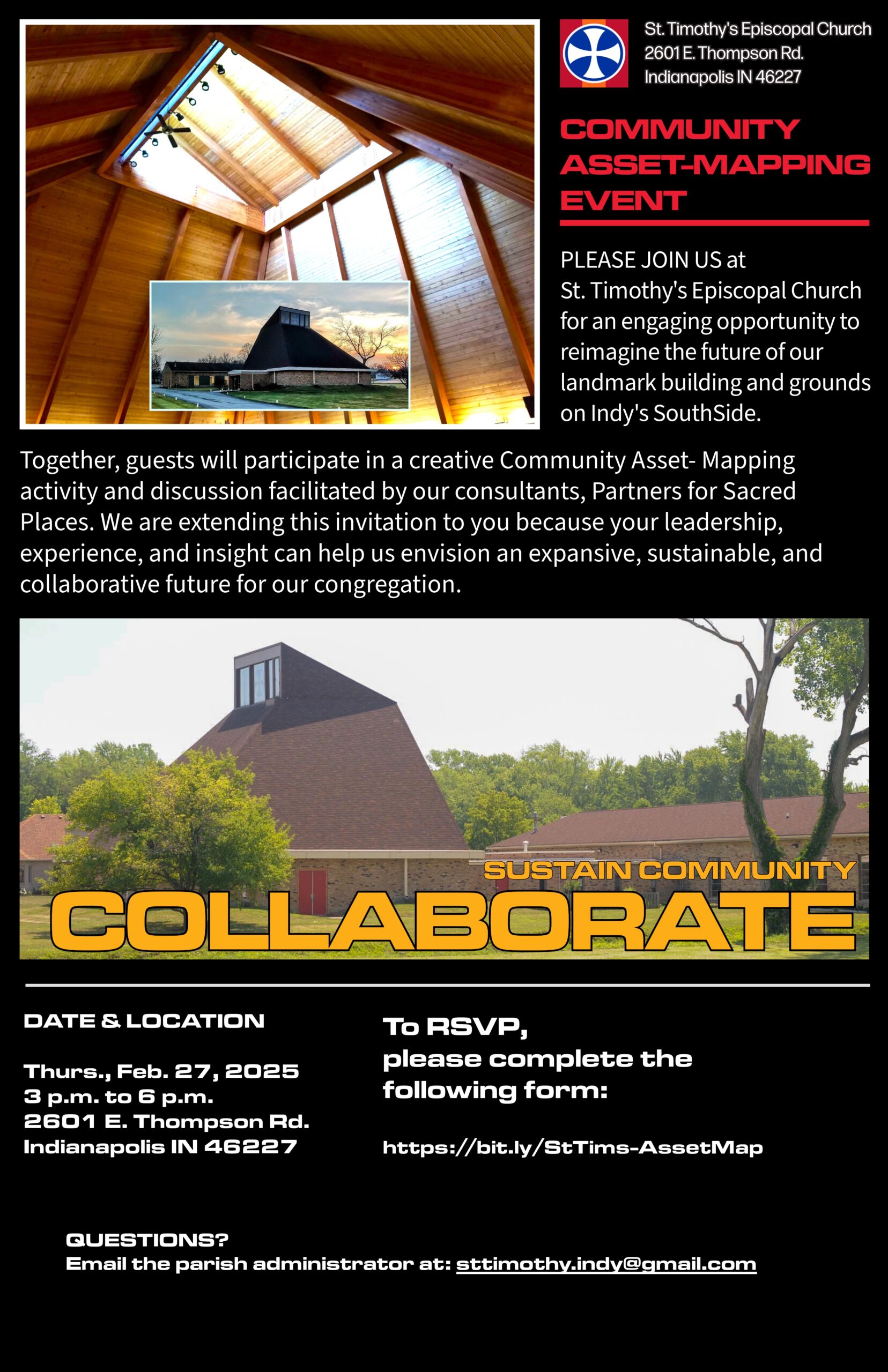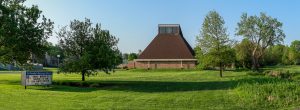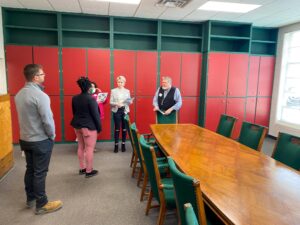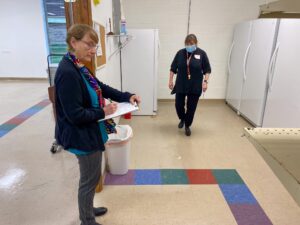Report to the Vestry
May 19, 2025
The “building church capacity team” has assessed the recommendations for programming from our collaboration partners as well as talked about ways in which the congregation can access a matching grant for building improvements that enhance programming. The process we have engaged in for the past couple of years has unlocked a way to pay for a total of $100,000 in building upgrades, requiring a 25 percent match from the congregation, 25 percent from the diocese, and 50 percent from the Church Building Community Partnerships grants program.
The congregation now has a fund from selling the adjacent property to the city for its stormwater detention construction project. The diocese has indicated it will support the future of collaboration by assisting with a 25 percent match.
This committee will report to the vestry soon.
A successful collaboration
May 7, 2025
The program time is here.
Feb. 14, 2025
By Steve Polston, Director of Digital Communications & Marketing
So much progress has been made this fall and winter toward launching our event that I can now announce that the date is February. 27.
We have invited scores of likely participants from our many community in Indianapolis, Southport, Beech Grove and Greenwood. RSVPs have been encouraging and we continue to re-send our invitations. We will need some parish volunteers to assist in welcoming visitors to the church grounds and we will ask at worship this week.
This is the visual invitation poster we’ve sent out, just so you can see how we are presenting ourselves. The much longer text explaining the event is too long to present here and I don’t want to truncate it to present it … rest assured that it is a complete explainer about the day’s activities.


Fall back to move forward.
Nov. 5, 2024
By Steve Polston, Director of Digital Communications & Marketing
In my last blog post, I noted that a program team at St. Timothy’s has been working for several months to find ways of understanding our assets and how they can be deployed to assist the community and the congregation.
And I previewed our collaborative partnerships meeting on Nov. 12.
As the committee assessed its real progress, we acknowledged that we are not fully prepared to launch this meeting, and so we have postponed it to early in 2025.
The Church Buildings for Collaborative Partnerships curriculum https://indydio.org/church-buildings-for-collaborative-partnerships/ has assisted us in defining our assets broadly, and to find those in the surrounding community who can help us know who we need to know, who we should know, so we can strengthen who we are.
As part of the Sacred Places program, Church Buildings for Collaborative Partnerships assists congregations in learning what assets their physical plant represents in the community. The process of relating the church physical plant to the community also involves seeing relationships and how the church can support others.
The committee that has engaged in this process is also comprised of members who serve on several other committees, including the property commission. The church is an entity of people, and the interlocking directorates are staggering to consider. We are not a stagnating church at all, but we have a lot of work to do that has stretched us quite a lot.
A key component of what we need to do for the collaborative partnerships event is to engage the congregation in self-guided tours of the facilities and outdoor areas. The tours should be conducted with a guide and with this in mind: what would I see if I was a stranger coming to the church property perhaps to rent a room or conduct a program? Look for this to occur in the next two months.
We have developed a list of names and contact information so we can invite a key group of community influencers to the church, but we have run out of time to receive enough responses to conduct the meeting. We anticipate that the number of potential visitors is at least twice as big as the number needed for a successful meeting, probably at least 25 people.
Reaching out has been a chore!
Nov. 1, 2024
By Steve Polston, Director of Digital Communications & Marketing
A program team at St. Timothy’s has been working for several months to find ways of understanding our assets and how they can be deployed to assist the community and the congregation.
But even as we have worked, we have slowly come to an enlightened stance that tells us we don’t know who we are, fully. Engaging with the SouthSide community can help us learn.
The Church Buildings for Collaborative Partnerships curriculum https://indydio.org/church-buildings-for-collaborative-partnerships/ has assisted us in defining our assets broadly, and to find those in the surrounding community who can help us know who we need to know, who we should know, so we can strengthen who we are. It’s complex, isn’t it?
As part of the Sacred Places program, Church Buildings for Collaborative Partnerships assists congregations in learning what assets their physical plant represents in the community. The process of relating the church physical plant to the community also involves seeing relationships and how the church can support others.
We have developed a list of names and contact information so we can invite a key group of community influencers to the church in early 2025. The purpose of that meeting is to introduce our physical plant (buildings and outdoor property) to folks who are strangers. As they assess what they see, we will ask them to brainstorm about opportunities, even changes, that can be made to welcome others.
This has been a chore, and difficult. Chris Kramer has been a star on this team, contacting dozens of potential invitees. The other star has been David Nickel, who is the leader of the group, keeping straight the next steps and communicating with the local and national team members. Other hardworking team members include senior warden Dr. Rose Anne Grasty, Aimee Formo, and me.
We will ask members of the congregation to take tours of the property – indoors and outdoors. The purpose is to think about what you might see as a visitor and potential new user by putting on a different pair of glasses. Through those looking glasses you might become more attuned to what others show you.
Once you see what others see when they come to this place, you might be inspired to reach farther with more confidence. This might mean finding new partners in the community to co-locate at this building, or acquiring more rental revenue, or opening the building to more service opportunities.
The image below is one I have developed for the partnerships program on Nov. 12 and for an icon going forward. It incorporates our mission statement and interprets the sense of open hospitality we practice with the sacred gifts of bread and wine, and even coffee and food … and the flowers that adorn the altar.
Next time — fall back to move forward.
Sowing and reaping.
Oct. 16, 2024
Steve Polston, director of digital communications & marketing
In previous blog posts, I have discussed the theory behind the “Church Buildings for Collaborative Partnerships”
As part of the Sacred Places program, the Church Buildings for Collaborative Partnerships assists congregations in learning what assets their physical plant represents in the community. But the process of relating church physical plant to the community also involves seeing relationships and how the church can support others.
We know very well that the congregation has supported the community in a significant way in the past 10 years when we connected our buildings to the city sewer system. That process required a way to handle storm water drainage, to separate it from the sewer. This process not only cost the church money for connecting to the sewer but meant we had to pay for storm water separation. The church paid for a lift station (pumphouse) to carry storm water away from the ditches. This benefitted the entire neighborhood and was a cost the church bore.
In recent years, the local government has studied further preserving the downstream livability of the neighborhoods impacted by storm drainage coming from ground higher than St. Timothy’s. St. Timothy’s is by no means the low spot, but the creek centered on our property periodically has flooded its banks, at times overwhelming the parking lots and creeping into our building. The entire property has – without a proper plan for hydrologic engineering – become a detention spot, and yet water still floods the lowest neighborhood adjacent to the creek flowing by the interstate several blocks away. Local government leaders have been in conversation with St. Timothy’s and diocesan leadership for a few years to acquire our land on the other side of the creek for use as a properly formatted detention pond.
When this happens, the impact of storm water will be managed by the contour of the land with predictable and better outcomes overall.
Preserving livability for our neighbors is a prime way in which St. Timothy’s supports the community.
That was a long divergence to set up this important narrative – St. Timothy’s has assets that support the community. But St. Timothy’s also needs to understand what assets it doesn’t know it has and in what ways it can further deepen its ties to the community. Those friendships are the current focus of the Collaborative Partnerships team at the church.
For the past couple of months, the team has brainstormed about organizations and people – by name – who should be invited to the church this fall for an exploration of our physical plant (our entire property and grounds). We believe this meeting will lead to ways in which we can find out what needs the community has that perhaps we can help fulfil. It will develop deep and abiding ties.
We believe that our relationships are beautiful and we look forward to their continued discovery
Next time — how we try to bring people closer.
Our sanctuary building as it faces Thompson Road.

Open doors and open hearts.
Oct. 5, 2024
Steve Polston, director of digital communications & marketing
In April 2022, about 25 members of community organizations participated in a tour and discussion at St. Timothy’s about the physical plant and organization structure of our parish facilities and programs. Several members of the leadership committees and congregation involved in the “Church Buildings for Collaborative Partnerships” participated. The meeting was organized by Rev. Rebecca Nickel and was a robust and lively meeting that allowed us to conduct tours and get to know people in the community organizations.
Rachel Stackhouse, PhD, also attended and took a lot of notes about the conversations initiated by members of the community. She also made copious notes about the condition and size of our rooms. Rachel Stackhouse is leading the congregation now in a guided asset recording exercise that will help us learn what the community around us (SouthSide) needs and what ways we might form connections and partnerships.
The conversations were enlightening and the people from the community reflected to us that we lived up to our commitment to offer radical hospitality and welcome. An amazing heart-to-heart conversation opened when a community organizer noted that she had long held bad feelings about the church (in general) and that she felt ill at ease coming to St. Timothy’s. But at the conclusion of our conversations, she said she felt positive that she could come to the congregation’s programs and feel welcomed and encouraged.
That one small incident provided a lot of energy to members of the congregation who were present. We often say that we see ourselves as a family because we support and encourage each other. We also are aware that the term “family” is so loaded with connotations that we should temper our use of the term outside of the context of our congregation. Our hearts grew larger during that moment, and we gathered more energy for the work of radically welcoming members of the community to use our building.
But the question we all ask is what possibilities are there for inviting the community to use our facilities and why should we concentrate so much energy on that effort?
In the blog last week, I proposed that studying our building as an asset and developing community relationships and assets might mean change. Will we want to change, and will it cost us? What will it cost us financially, or in the terms of how we welcome others?
I am enjoying my membership on the “Building Capacity2 (squared)” committee because we have moved to the stage of studying our buildings and properties with an eye on what visitors experience.
Next time — how we try to bring people closer.

Visitors on a tour of our rooms in April 2022.
No barriers to entry – no steps to climb.
Imagine if the angel couldn’t trouble the waters because there were too many barriers to entry. Imagine if Jesus had sent the patient to the pool but they couldn’t enter because there were too many steps, too many people. (John 5:1-18)
Sept. 20, 2024
Steve Polston, director of digital communications & marketing
Hi everybody!
We’ve heard the name of the grant-supported project a small and trustworthy parish leadership team has been engaged in for the past two years called “Church Buildings for Collaborative Partnerships.”, with the Partners for Sacred Spaces.
The diocesan office has promoted this collaborative discovery method to help congregations engage in deep study and planning called “Building Capacity2 (squared)”. St. Timothy’s is receiving customized support from the program staff of this national asset mapping curriculum to make sure we can know ourselves really well before making any changes to our building.
There are two traditionally scary things about studies in churches – people ask the question, “will I have to change?” and “will this cost money?” It’s just like the dynamic in any family in our parish; we responsibly watch our budgets and take care of our values.
I just subtly mentioned changes in our building, and I want to make sure I address that topic. I’ll pose a question – think of the last Sunday you entered the church building through any doorway from the outside. Did you step up? No, you did not. Were you forced to make a step up to participate in any activity in the building that did not also have an equal experience with no steps? That second question is a little mouthful, isn’t it?
Before you answer, think about what our sanctuary looks like. Now, there is a series of steps up to sit in the pews that look down on the Sanctuary dais, that raised flooring that comprises the altar, lectern and pulpit. If you want to see the action you actually can sit in a series of eye-level pews, or you can climb steps to sit in pews above eye level. A good experience to re-live right now is to look at last week’s livestream of our worship service on Pentecost 17 (Sept. 15).
Back to that question of entering the building. Did you step up or over an entry? No, this is a zero-barrier building. Think of how many public facilities in our community have steps and because of that signal that entry is difficult for people who can’t climb steps.
As we consider studying this primary asset characteristic of our church buildings, we have this beautiful little thing we can smile about. There is no physical barrier to entry, and this is a welcoming statement.
Next time – how have we engaged the community?

Above: Rachel Stackhouse, PhD, is a program consultant for the collaborative partnerships study the parish is engaged in. She toured the building and made detailed notes during a community meeting in April 2022. Pictured with her is Rev. Rebecca Nickel, rector.

